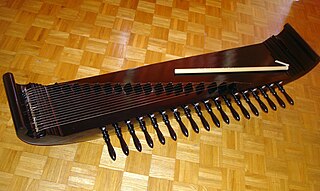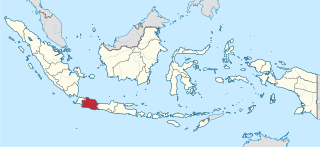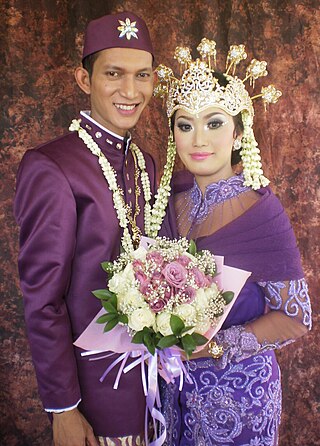
Gamelan is the traditional ensemble music of the Javanese, Sundanese, and Balinese peoples of Indonesia, made up predominantly of percussive instruments. The most common instruments used are metallophones and a set of hand-drums called kendang, which keep the beat. The kemanak, a banana-shaped idiophone, and the gangsa, another metallophone, are also commonly used gamelan instruments on Bali. Other notable instruments include xylophones, bamboo flutes, a bowed string instrument called a rebab, and a zither-like instrument called a siter, used in Javanese gamelan. Additionally, vocalists may be featured, being referred to as sindhen for females or gerong for males.

As it is a country with many different tribes and ethnic groups, the music of Indonesia itself is also very diverse, coming in hundreds of different forms and styles. Every region has its own culture and art, and as a result traditional music from area to area also uniquely differs from one another. For example, each traditional music are often accompanied by their very own dance and theatre. Contemporary music scene have also been heavily shaped by various foreign influences, such as America, Britain, Japan, Korea, and India.

Celempungan is a Sundanese musical genre that includes several musical instruments such as kacapi, kendang, goong/gong, and suling or rebab (optional), and Juru Kawih (singer). Kendang, the drum, controls the tempo of the ensemble and reinforces the meter.

The kacapi is a traditional zither of Sundanese people in Indonesia. This musical instrument is similar to Chinese guzheng, Japanese koto, the Mongolian yatga, the Korean gayageum, the Vietnamese đàn tranh and the Kazakh jetigen. The kacapi played as the main accompanying instrument in the Tembang Sunda or Mamaos Cianjuran, kacapi suling genre, pantun stories recitation or an additional instrument in Gamelan Degung performance.

Gamelan degung is a form of Sundanese musical ensemble that uses a subset of modified gamelan instruments with a particular mode of degung scale. The instruments are manufactured under local conditions in towns in West Java such as Bogor and Bandung. Degung music is often played at public gatherings in West Java, such as at local elections, as well as many other events. There is international interest in degung as well among communities in other countries interested in Indonesian and gamelan music.

West Java is an Indonesian province on the western part of the island of Java, with its provincial capital in Bandung. West Java is bordered by the province of Banten and the country's capital region of Jakarta to the west, the Java Sea to the north, the province of Central Java to the east and the Indian Ocean to the south. With Banten, this province is the native homeland of the Sundanese people, the second-largest ethnic group in Indonesia.

The angklung is a musical instrument from the Sundanese in Indonesia that is made of a varying number of bamboo tubes attached to a bamboo frame. The tubes are carved to produce a resonant pitch when struck and are tuned to octaves, similar to Western handbells. The base of the frame is held in one hand, while the other hand shakes the instrument, causing a repeating note to sound. Each performer in an angklung ensemble is typically responsible for just one pitch, sounding their individual angklung at the appropriate times to produce complete melodies.

The suling is a musical instrument of the Sundanese people in Indonesia. It is used in the Degung ensemble. Bamboo ring flute can also be found in Southeast Asian, especially in Brunei, Indonesia, Malaysia, the Philippines and Singapore.

The Sundanese are an indigenous ethnic group native to the western region of Java island in Indonesia, primarily West Java. They number approximately 42 million and form Indonesia's second most populous ethnic group. They speak the Sundanese language, which is part of the Austronesian languages.

The đàn tranh or đàn thập lục is a plucked zither of Vietnam, based on the Chinese guzheng, from which are also derived the Japanese koto, the Korean gayageum and ajaeng, the Mongolian yatga, the Sundanese kacapi and the Kazakh jetigen. It has a long soundbox with the steel strings, movable bridges and tuning pegs positioned on its top.
The kutiyapi, or kudyapi, is a Philippine two-stringed, fretted boat-lute. It is four to six feet long with nine frets made of hardened beeswax. The instrument is carved out of solid soft wood such as that from the jackfruit tree.
Pantun Sunda is a type of Sundanese oral narrative performance interspersed with songs and music played on a kacapi, a kind of zither. A pantun is intended to be recited during an evening-length performance during which a single performer relates the story of a hero's initiation: The protagonist leaves his kingdom to seek experiences, beautiful princesses to become his wife, power, other kingdoms to the subject, the realization of a dream ; after having succeeded in reaching his goal he finally returns to his kingdom. Alongside descriptions of historical events, the stories often contain mythical elements. Pantun were originally not written down, the bards often being illiterate and in many cases blind. Originally the performances had a sacred character, as was clear from the offerings made at the beginning of the recitation and also from the content of the introductory part of the story, called rajah, which was an invocatory song, imploring the help of divine figures to ward off bad influences. The linguistic form of the pantun was not strictly fixed, however, the dominant form employed in most pantun is the octosyllabic verse. For a detailed description of the nature and form of a Sundanese pantun you are referred to Eringa (1949), to Hermansoemantri (1977–79).
Sisindiran is a Sundanese poem in which an allusion (sindir) is given by a combination of words which allude to the real meaning by sound association. Sisindiran (susualan) are often found in Sundanese verse: in tembang Sunda they occur mainly in the Panambih Songs. They invariably consist of a cangkang without meaning, followed by a eusi, the real meaning. The association between the "cover" and the real meaning is indicated by structural correspondences of sound and patterns. If the sound patterns of the cangkang and the eusi are parallel, the sisindiran is termed a paparikan. This is the case for instance, in the following poem where the first two lines constitute the cangkang and the third and the fourth lines the eusi:

Kacapi suling is a form of Sundanese music from Indonesia. It is essentially tembang Sunda minus vocals, and also at interludes between songs at a typical Tembang Sunda performance. The higher pitched kacapi rincik, the lower pitched kacapi indung and the suling flute are the instruments used for kacapi suling. Kacapi suling has instrumental pieces performed in two different scales; the first four in laras pelog convey a light mood, the last four, in laras sorog are more slow and grave. The change to laras sorog usually takes place at midnight and lasts until sunrise.

SambaSunda is an Indonesian ethnic music fusion group based in Bandung, the capital and cultural centre of Sundanese culture, Indonesia. SambaSunda are a 14-piece ensemble bringing together a pan-Indonesian array of instruments and influences to create a new style gamelan orchestra. Their style mainly influenced by Sundanese culture such as gamelan and degung Sunda, Tembang Sunda and Kacapi suling.

Sundanese dances is a dance tradition that is a part of ritual, artistic expression as well as entertainment and social conduct among the Sundanese people of West Java and Banten, Indonesia. Sundanese dance is usually cheerful, dynamic and expressive, with flowing movements in-sync with the beat of kendang accompanied with Gamelan degung music ensemble.

Sandiwara is a genre of traditional theatrical drama of Indonesia. In general, it refers to any kind of drama or theatrical performances, and literally sandiwara means "to pretend" or "to act". However, the term is often used to describe a genre of traditional drama of West Java. Sandiwara Sunda is a type of sandiwara performed in Sundanese and presenting Sundanese themes, folklores and stories. It is quite similar to Javanese ketoprak or wayang orang.

West Java Syndicate is an Indonesian ethnic-fusion music group founded in 2010 in Bandung, Indonesia. The group seeks to promote a wide variety of world music based on Sundanese music using traditional Sundanese musical instruments, as well as exploring contemporary styles.

Sundanese Music is an umbrella term that encompasses diverse musical traditions of the West Java and Banten in western part of Java, Indonesia. The term of "West Java" is preferred by scholars in this field. The word "Sundanese" originally referred to western part of Java Island and has a strong association with the highly centralized Sunda Kingdom based on Java Island and its high culture practiced by the nobleman class in its capital Parahyangan. By contrast, scholars who cover a much broader region lay emphasis on folk culture.

Sisingaan or also known as Gotong Singa, Singa Ungkleuk, Singa Depok, Kuda Ungkleuk, Pergosi or Odong-odong, is a traditional Sundanese lion dance originated from Subang, West Java, Indonesia. This lion dance performance marked by a form of an ark or palanquin that resembles a lion. The lion ark or lion-shaped effigy is carried by a group of dancers who perform various attractions accompanied by traditional music. The lion palanquin is being ride by a children. This dance usually performed to celebrate the child's circumcision ceremony, where the child is carried on a lion around the kampung (village).















